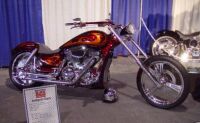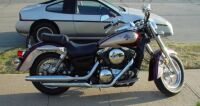 Customarily
Minded Customarily
Minded |
Welcome
to the third installment of my column, appropriately entitled
"Customarily Minded." Unlike the title suggests, I won't
be writing about custom modifications each and every month. Granted
it's something I love to write about and something I enjoy carrying
out even more, let me take a moment and tell you what this column
is going to deal with for the most part.
The word "customarily" comes from the root customary,
which defined is "based on or established by a custom; commonly
practiced, used, and observed." With that in mind, let's
dive head first (wearing a DOT approved helmet) right into what
I hope becomes a repeated custom here at Beginner Bikes:
 Outgrowing
A Beginner Bike Outgrowing
A Beginner Bike |
"Don't buy that bike, you'll outgrow it and only come back
to buy a larger one later. Here, I think you'd really like the Kamikaze
Light-Speed 900XR, this is a great starter bike that you can grow
into." This is something that most potential/future bikers
hear at just about any dealership when asking about a particular
smaller sized motorcycle. Some speculate it has to do with greed,
the sales associate wants to sell a bigger bike in order to line
his/her pockets with the higher commission. Others feel that there
is just some type of ego trip involved with a bigger machine. Yet
the wise salesperson will sell the entry level bike and treat the
new customer right, with the idea of said customer returning after
a few seasons to upgrade and thus make a second sale. With that
in mind, let's take a good close look at what outgrowing a bike
is really all about.
Top
Speed/Acceleration: Okay I'll be the first to admit that
the entry level bikes really don't excite me much in this category.
Granted if you wind up a 250cc bike enough you can still outaccelerate
a majority of the automobiles from a stop, the powerband quickly
begins to fade away right when things get interesting. But are we
buying a learning tool for the sole purpose of beating land speed
records? I think not, an orangatan can go 170mph in a straight line.
Nay, we buy a learning tool to hone our skills. Back when we were
16 years old and getting our drivers license and first car, what
did we start off with? Ferraris, Corvettes, Porsches, and Cadillacs?
Perhaps the small majority of folks from wealthy families did, but
for the rest of us in the real world we started off in an old clunker
or something simple with four small cylinders (I had a V-6 with
four functioning cylinders). That said we can safely rule out machines
such as the Hayabusa, VTX1800, R-6, and Electra Glide as a first
bike. Please don't let the misconception of higher speeds be the
determining factor of outgrowing a bike.
Turning/Cornering: Hands down one of the more complicated
maneuvers on a motorcycle. Too many factors are involved in these
maneuvers to chance performing them on too much bike. If your bike
has sensitive brakes, a beginner can grab too much lever and lock
the front wheel. Do that in a turn that's called wiping out. If
your bike has a sensitive throttle, a beginner can grab too much
and make the back wheel spin out (or in some cases wheelie). Do
that in a curve that's called a road rash formula. If your bike
is on the heavy side and you encounter sand/dust/dirt/gravel/oil
in acurve, the resulting momentum can be too much for a beginner
to handle, causing a low side. The resulting effect is also known
as nipple surfing. The entry level bikes are well suited for turning
and cornering maneuvers, offering excellent frame geometry, low
weight, and more forgiving brakes and throttle for such maneuvers.
Hence one can really build their riding skills from scratch on such
a machine. Once a person has come to a level of mastery over the
smaller bike, he/she will be ready for the next step up and thereby
have a solid basis or foundation by which to handle the more "aggressive"
machine.
Braking: Another noteworthy aspect is most bikes
come with brakes that are well suited for their size and weight.
But once again this doesn't mean that a new rider can learn efficient
braking ona CBR954 or a Valkyrie. The dual discs on the CBR are
real touchy and performing an endo (basically a front wheel wheelie
performed while stopping) is very easy to do on the CBR if you know
how. If you don't know how then that means the front wheel can be
locked up very easily, and this isn't something you really want
to do in many situations. On the same note the Valkyrie comes with
some incredibly smooth and powerful brakes to haul an 800 pound
machine from 60mph to 0mph, but how many inexperienced riders know
how to throw around that 800 pounds worth of weight into the equation?
When that bad boy starts to tip over too far, there's no stopping
it. And getting it back upright is another story. And speaking of
weight...
Weight: Something I feel is very important to stress
in a learning tool. As noted earlier, the brakes on larger bikes
are more than adequate to slow them down. Weight becomes a major
factor in the turning/cornering equation. Heavier bikes turn slower,
that's a given from the laws of physics. Anyone remember centrifugal
force? Take a string and tie a small weight to one end and swing
it around your head, then repeat with a larger weight. The heavier
one takes more force to move at similar speeds as the lighter one.
The heavier one also has more risk of snapping the string and flying
away. Translated to motorcycling, the heavier bike requires more
skill to throw around a set of curves, and if it should "snap"
and get away from you (such as from encountering road hazards) the
momentum will be greater and your chances of recovery decrease in
proportion with mass. 100 extra pounds of motorcycle translates
into 100 more pounds that you multiply by the velocity to yield
the momentum that you will attempt to keep on the road, should you
happen to hit that patch of loose gravel or oil in the turn. Remember,
the bigger they are the harder they fall. And by harder I don't
mean more difficult...the size of the impact is what I'm getting
at here.
Engine Power: This goes hand in hand with Top Speed/Acceleration.
Many potential entry level riders theorize that the smaller bore
engines lack the power to haul them (and/or their significant other)
around town. A 250 Rebel won't be the ideal choice for pulling tree
stumps out of your yard with its 16 horses & 12 foot/pounds
of torque, whereas a Harley Davidson FXR with a stroker motor can
do it all day long. Yes, there are some folks that tip the scales
upwards of 300+ pounds that want to learn how to ride, and many
seem to think these micro-bikes lack the power to carry them from
point A to point B with any degree of efficiency. Allow me to put
this theory to rest: back in the 1800's families loaded themselves
and all their belongings into wagons that were hauled across uneven
terrain by one or two horses. If one or two horses could conquer
the wild west's rocky terrain, a Rebel's 16 horses should have no
problem hauling 300 pounds across smooth asphalt. To immortalize
the Energizer Bunny: "Keep growing, and growing, and growing..."
 Real
World Story Real
World Story |
About the only thing I can see as a bad thing would be the depreciation
of a new beginner bike purchase. It has always been my suggestion
to buy used the first time, learn on the bike, and turn it around
a few seasons later for a fraction less than what you paid for it.
If you feel you can't afford buying a bike that you'll only later
sell for the purpose of upgrading (the common sales excuse used
to buy larger from the beginning), then you really have no business
looking at new bikes in the first place. Buy what you can afford,
it's that simple. Buy used and you can save a bundle, you'll need
it for proper gear, insurance, and registration so it's nice to
have some cash left over for that rather than tied up in a bike
you can't afford.
Turning a used $1500 bike around for $1200 isn't a loss when you
consider the skills you gain for $300 (how long can you rent a vehicle
for at $300?). Those skills will come in handy when you get your
next bike, new or used. On the other hand, wiping out your first
brand new $10,000+ bike hurts far more than just your wallet...you'll
see remarks like this throughout the various postings here at the
Beginner Bikes Forum so it isn't just me.
That said, we'll look at outgrowing your beginner bike. Is it such
a bad thing? Mastering your skills in order to advance to the next
level, I see nothing bad about that. Someone here at the BB forum
once said "before you can run, you must learn to walk. Before
you can walk, you must learn to crawl. Before you can crawl, you
must learn to get up off your stomach." Ever seen an infant
jump out of the crib and bolt out the door running? And so it is
with motorcycles. Master one phase, move on to the next.
Once a rider is able to gain a good foundation for acceleration,
braking, and maneuvering and has explored the full potential of
each, he/she will be better prepared to handle the next larger machine.
After all, we can agree that utilizing 90% of a smaller motorcycle's
capabilities most of the time is much more fun that utilizing 20%
of a larger bike's capacity all the time. Rather than purchase said
next larger machine from the beginning and attempting to "grow
into it," the new rider will have more fun utilizing the full
potential of the learning tool right away. To that I will add the
following true story (names and machines have been altered to protect
the innocent, and guilty...):
Once upon a time there were three riding buddies who all came from
different backgrounds. Robert, Sam, and Mike have been riding together
for the past 5 years. Rob started riding 8 years ago on a Kawasaki
500 Vulcan, Sam started off 15 years ago on a Suzuki GS300, and
Mike started riding 22 years ago on a 100cc Honda dual sport. All
have owned more than one bike since then. Rob still has the 500
Vulcan, acquired an 1100 Shadow that he sold after a few years in
favor for his dream bike that he has now: a brand new Harley Davidson
V-Rod, and he also owns a 250 Virago that his wife is learning on.
Sam took nine years off from riding the old Suzi 300 and then bought
an ST1100, and after a few less than masterful riding years he traded
it towards a brand new ZX-12R. Mike went from the small bore dual
sport to a Kawasaki KZ-454 to a Honda 650 Hawk to a VFR750 Interceptor
and now has the same bike Sam does, a ZX-12R (in addition to a limited
production RC-30 and a Suzuki SV650).
While Rob and Mike are fortunate enough to have more than one choice
as to what to ride on any given day, Sam has the one and only choice.
Which isn't a bad thing but read on. Rob and Mike had the benefit
of a decent foundation prior to obtaining their dream machines,
Sam did not. All three started off on appropriate learning tools,
but Rob and Mike graduated to a more intermediate level of machine
prior to obtaining their "super bikes," whereas Sam took
almost a decade's worth of time out from his learning tool and jumped
on to a liter sized sport/touring bike, relearned to ride it for
a few years and then acquired his "super bike" which consequently
is the same machine as Mike has.
Robert is a fair rider and knows the limitations of his machines.
Mike is an exceptional rider and can perform amazing feats on his
sportbike, whether it be stunts in a parking lot or dragging his
knees through some fast paced S-curves. Sam on the other hand has
virgin tread on the outer third of both tires' tread surfaces, replacing
them when the tire profile looks similar to that of an automotive
tire. You see, Sam never learned the full potential of cornering.
He jumped from a beginner bike to a 700+ pound sport/tourer after
a lengthy hiatus from riding, whereas Rob and Mike never stopped
riding and graduated to intermediate machines prior to the acquiring
the bad boys.
Sam has the misconception that his 160HP machine is superior on
paper to any of Rob's bikes, yet when all three go canyon blasting
it's Sam who is playing the role of caboose (even when Rob brings
the "diminuative" 500 Vulcan along). Sam ended up eating
his words one day concerning Rob's trainer (the 250 Virago), when
he made the quip about "I can walk faster than that runt bike."
You see, his philosophy stems from one thing and one thing alone:
acceleration/top speed. Sam thinks that because his bike sports
the highest horsepower out of any production machine and ranks second
in top speed and 1/4 mile times, that his is the superior machine.
Until Rob challenged him to one of their favorite sets of twisties
on the 250.
Sam led the way for the first half of the run, until the mid point
that features a tight and blind 180º right hairpin curve that
opens up into a pair of left-to-right 90º open curves. Sam
slows down to a crawl for the blind turn taking the inner third
of the lane. Halfway around the blind turn (where it's no longer
blind), Rob sees no oncoming traffic, downshifts and zips along
the outside/opposing lane (which quickly becomes the inside of the
next 90º curve) and knifes right past Sam, who is busily over-correcting
his poor choice of curve negotiation. Rob accelerates through the
pair of opposed nineties and Sam is never able to catch up until
the road straightens out at the end of the course (where the road
intersects the main road). All this on a ZX-12 Ninja super sport
versus an "itty bitty" 250 Virago cruiser. Rob carefully
chose the "longest path" through the curves while Sam
took the seemingly shorter line of travel. Rob was able to spend
more time accelerating while Sam was busy braking, accelerating,
braking, accelerating, all the while fuming that a 250 Virago just
"walked right by him."
Now why did this seemingly impossible event occur? If it was Rob
versus Mike it probably wouldn't have happened the same way. Even
though Sam and Mike have the same motorcycle, it is Sam that marvels
at the way Mike rides, only wishing he had "half the balls"
Mike has. What Sam doesn't grasp is that it isn't "balls,"
rather it's this thing called "skill." Skill that was
acquired on learning tools along the way, in the form of the two
mid sized bikes followed by the Interceptor prior to buying the
big 1200 Ninja. Skills that Rob gained from his 500 Vulcan and 1100
Shadow prior to acquiring his "ultimate power cruiser"
the V-Rod. Sam's skills stem from a decade long abscense semi-mastery
of a beginner bike followed by a few years of an 1100cc sport tourer
that is anything but crisp in the curves, thanks to its sheer weight
combined with inexperienced hands. Until Sam swallows his pride
and opens his mind to the idea of buying a mid sized sport bike
to learn on, he probably will never learn how to wear the outer
third of his tread surface.
It's really a shame that Sam outgrew his beginner bike so quickly.
See ya next month, until then keep the shiny side up!
|
 Bike
Of The Month Bike
Of The Month |
This Month's
Customarily Minded Motorcycle:

And now with
the idea of outgrowing your bike put out to pasture, I'd like
to share with all of you a spectacular machine that is truly "Customarily
Minded." This bike was taken in for a major face lift to
the friendly folks at Coyote Customs and came back a different
breed. The engine features silver powder coating on the exterior
that hides a Thunder Big Bore kit fed via one of their air kits,
and a Dyna 3000 ignition module helps spark things up on the inside.
All that go go gets ventilated through a pair of sawed off Vance
& Hines Longshots.
The frame
has been raked out to 40º and a set of polished billet +4º
wide glide trees feeds the sloping forks. A 21" Performacne
Machine wheel rounds out the chopper equation. The rear features
air suspension and an RC Compnents 18"x 5.5" solid disk
wheel with a juicy 200mm Metzler hoop. Custom fenders, rear brake
mount, seat, handlebars, and a license tag mount completes the
chrome and style package, and a killer House of Kolor paint job
finishes it off.
So can
anyone guess what this radical custom began life as?

Kawasaki
1500 Vulcan Classic
And just for
the record, neither rendition of this bike is a good idea to attempt
growing into as a first bike.
|

